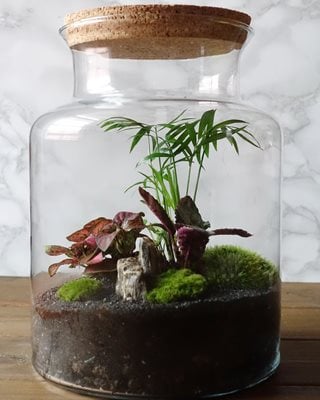Top 10 DIY Terrarium Tips
Learn how to make a terrarium, the best plants for terrariums, care, maintenance and more.
Photo by: qnula / Shutterstock.
Terrariums make it possible to grow things in places that aren't exactly conducive — like your dry, low-light work space or your equally moisture-deficient living room. A closed terrarium becomes a biosphere where humidity is elevated, plants are self-watered and the mini ecosystem just chugs along on autopilot with minimal intervention.
If memories of past terrarium fads are flooding back, rest assured, today's terrariums are more about bringing nature indoors and less about filling far-out fishbowls. And garden design definitely comes into play, albeit in a drastically reduced landscape.
Here are some hints to get you started:
1. Find a suitable container.
Start by digging out that stray vase, canning jar, apothecary jar, candy dish, cookie jar or whatever — almost anything works. If you can get your hands in the mouth of whatever you're planning to use, it will make it easier. A lid makes the environment lower-maintenance. But even if the container doesn't come with a lid, you can always top with a glass plate or leave the container open and check it for moisture more often. (Shop terrariums on Amazon.)2. Select appropriate plants.
For closed-top terrariums, plants should be compact, humidity-loving and low-light compatible. Good choices are mosses and ferns, as well as orchids, bromeliads and many other easy-to-find houseplants. Avoid plants that prefer bright light and low humidity — cactuses, succulents and most herbs (mints are okay) — these types of plants work well in an open-top terrarium. See: Top 16 Terrarium Plants for Open & Closed Containers.3. Use the right tools.
When working in a small space with limited access, it helps to have tools that are just the right size for the job, like in this terrarium tool kit.4. Place the foundation.
Add small pebbles for the base layer to encourage drainage. Top with a thin layer of charcoal to absorb excess moisture and reduce bacteria and odors.5. Add potting soil.
For a planting medium, select a light, humus-soil potting mix. Add enough soil to cover plant roots.6. Plant your plants.
Firm the plants in when you plant them, just as you would in the garden bed, and water your terrarium very lightly after planting. Close it up and watch the biosphere swing into action.7. Get creative.
Let those creative juices flow when designing a terrarium. Mix textures, add a small orb, marble or faux mushroom to serve as a complement. Think color, think balance and unleash your inner landscape architect.8. Find the right location.
Place your terrarium in indirect light. Direct sun can fry the contents.9. Keep it clean.
Remove any dead or wilted leaves promptly to keep your eco-system healthy.10. Get some fresh air.
Every 10 days or so, give the terrarium a little fresh air. Open the lid for half a day, then close it up again. If no condensation appears after closing, add a very small amount of water.

Photo by: tarapong srichaiyos / Shutterstock.
It's simple, it's fun, it's creative and it can change your world.
RELATED:
Garden Under Glass
DIY Garden Ideas
Last updated: August 20, 2019


